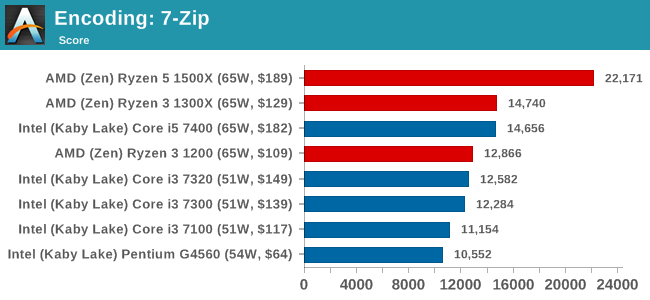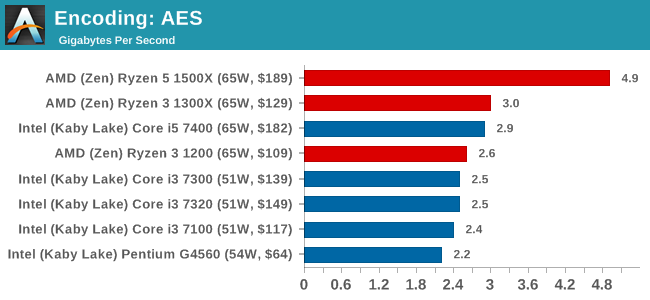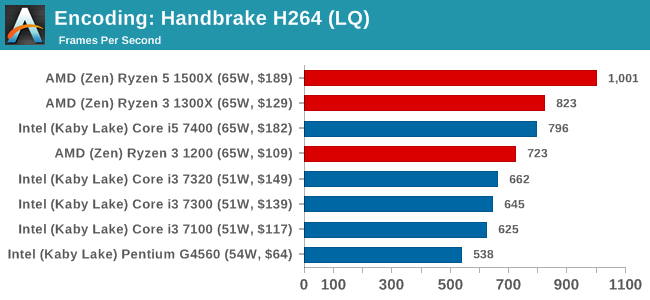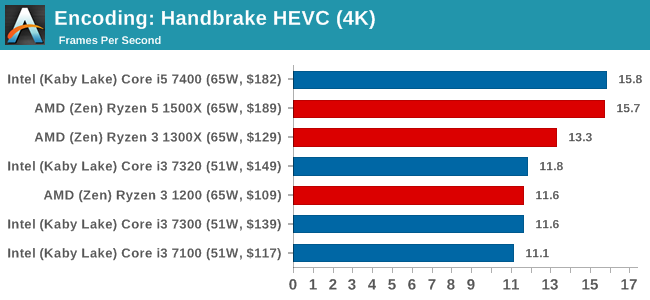The AMD Ryzen 3 1300X and Ryzen 3 1200 CPU Review: Zen on a Budget
by Ian Cutress on July 27, 2017 9:30 AM EST- Posted in
- CPUs
- AMD
- Zen
- Ryzen
- Ryzen 3
- Ryzen 3 1300X
- Ryzen 3 1200
Benchmarking Performance: CPU Encoding Tests
One of the interesting elements on modern processors is encoding performance. This includes encryption/decryption, as well as video transcoding from one video format to another. In the encrypt/decrypt scenario, this remains pertinent to on-the-fly encryption of sensitive data - a process by which more modern devices are leaning to for software security. Video transcoding as a tool to adjust the quality, file size and resolution of a video file has boomed in recent years, such as providing the optimum video for devices before consumption, or for game streamers who are wanting to upload the output from their video camera in real-time. As we move into live 3D video, this task will only get more strenuous, and it turns out that the performance of certain algorithms is a function of the input/output of the content.
All of our benchmark results can also be found in our benchmark engine, Bench.
7-Zip 9.2: link
One of the freeware compression tools that offers good scaling performance between processors is 7-Zip. It runs under an open-source licence, is fast, and easy to use tool for power users. We run the benchmark mode via the command line for four loops and take the output score.

WinRAR 5.40: link
For the 2017 test suite, we move to the latest version of WinRAR in our compression test. WinRAR in some quarters is more user-friendly that 7-Zip, hence its inclusion. Rather than use a benchmark mode as we did with 7-Zip, here we take a set of files representative of a generic stack (33 video files in 1.37 GB, 2834 smaller website files in 370 folders in 150 MB) of compressible and incompressible formats. The results shown are the time taken to encode the file. Due to DRAM caching, we run the test 10 times and take the average of the last five runs when the benchmark is in a steady state.

AES Encoding
Algorithms using AES coding have spread far and wide as a ubiquitous tool for encryption. Again, this is another CPU limited test, and modern CPUs have special AES pathways to accelerate their performance. We often see scaling in both frequency and cores with this benchmark. We use the latest version of TrueCrypt and run its benchmark mode over 1GB of in-DRAM data. Results shown are the GB/s average of encryption and decryption.

HandBrake v1.0.2 H264 and HEVC: link
As mentioned above, video transcoding (both encode and decode) is a hot topic in performance metrics as more and more content is being created. First consideration is the standard in which the video is encoded, which can be lossless or lossy, trade performance for file-size, trade quality for file-size, or all of the above can increase encoding rates to help accelerate decoding rates. Alongside Google's favorite codec, VP9, there are two others that are taking hold: H264, the older codec, is practically everywhere and is designed to be optimized for 1080p video, and HEVC (or H265) that is aimed to provide the same quality as H264 but at a lower file-size (or better quality for the same size). HEVC is important as 4K is streamed over the air, meaning less bits need to be transferred for the same quality content.
Handbrake is a favored tool for transcoding, and so our test regime takes care of three areas.
Low Quality/Resolution H264: He we transcode a 640x266 H264 rip of a 2 hour film, and change the encoding from Main profile to High profile, using the very-fast preset.

High Quality/Resolution H264: A similar test, but this time we take a ten-minute double 4K (3840x4320) file running at 60 Hz and transcode from Main to High, using the very-fast preset.

HEVC Test: Using the same video in HQ, we change the resolution and codec of the original video from 4K60 in H264 into 4K60 HEVC.











140 Comments
View All Comments
haukionkannel - Thursday, July 27, 2017 - link
You can install Ryzen 1200 and use Nvidia 1080ti and run games at 4K easily, so there is a point of these prosessors.There will be Ryzen based APU later in this or next year for Office computers and maybe even htpc usage and laptops. Those Are budget CPU for gaming and you can pair them as fast GPU as you like and still get reasonable good results!
The Intel 7700 is in the top, but if you run games at 4K I think that you can save a big deal by usin amd 1200 instead of Intel 7700! The difference is so small in speed and so big in money!
kaesden - Thursday, July 27, 2017 - link
dont forget that ryzen 1200 with a 1080ti could also have a 1700 dropped in down the line when budget allows, or when more cpu performance is needed. And the ryzen based APU's are coming eventually for those who just want basic integrated graphics. AMD isn't finished yet with their roll out.zodiacfml - Thursday, July 27, 2017 - link
The purpose is to make use/sell of disabled chips. This could be the reason why AMD and Nvidia started selling the new, lowest end discrete graphics cards. Desktop APUs will arrive early 2018.I wonder if AMD will ever have to cripple these Zen parts in the future as some articles mention they have high pretty good wields.
lefty2 - Thursday, July 27, 2017 - link
They aren't "making" a $100 CPU with no iGPU, they are just re-badging a $500 CPU. Much cheaper in research costs than having to design a new die. ...and the same logic applies to the 7700Kbennyg - Thursday, July 27, 2017 - link
I think the price/perf discussion should be a it broader in scope than just comparing CPU alone. The need to find or buy a GPU for the R3 compared to the Intel competition is a noticable omisson. Even the budgestest secondhandest GPUs will throw out the metrics of a $30 price comparison, but the extra graphics performance and/or features you may get from a dedicated GPU over iGPU should also be considered.bennyg - Thursday, July 27, 2017 - link
should be a *lot* broader. typoManch - Friday, July 28, 2017 - link
That's why these were tested with the higher end GPU's. To eliminate the IGP as a performance factor and compare CPU only. As you said, the extra performance you would get from even a low end discrete would be an unfair advantage for AMD. If you got one that was crappier than the IGP(if possible) then it would be an unfair advantage to Intel. It would be hard to decide which Discrete card would be the official stand in. On that note, doesn't AMD have discrete R7 cards that are paired with their APU's that are pretty much a copy of the IGP? They're not VEGA cores though so it wouldn't be a good way to predict the performance of the upcoming APU's. It would however give an idea as to what Bristol would have been using ZEN cores.extide - Saturday, July 29, 2017 - link
Latest AMD APU's are still construction cores (Excavator) with Polaris based graphics. Ryzen with Vega based will come later.Alexvrb - Thursday, July 27, 2017 - link
I don't know... maybe... gaming on a relatively small budget? Ryzen 3 plus a $150-200 graphics card is clearly better than an equivalent i3 build, plus they overclock even with a cheap B350 board.serendip - Friday, July 28, 2017 - link
For a cheapo gamer like me, Ryzen 3 + a $100 card is fine, but how big is that market anyway?AMD needs to go beyond servicing enthusiasts, it has to get OEMs to use Ryzen in cheap PCs for basic use in schools, homes and businesses. These segments won't bother going for Ryzen 5 or i5, they just want the cheapest computer available. AMD doesn't have a good name in the low end of the market because of its terrible APUs.